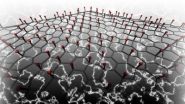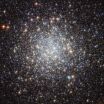(Press-News.org) Astronomers using NASA's Hubble Space Telescope have found several examples of galaxies containing quasars, which act as gravitational lenses, amplifying and distorting images of galaxies aligned behind them.
Quasars are among the brightest objects in the universe, far outshining the total starlight of their host galaxies. Quasars are powered by supermassive black holes.
To find these rare cases of galaxy-quasar combinations acting as lenses, a team of astronomers led by Frederic Courbin at the Ecole Polytechnique Federale de Lausanne (EPFL, Switzerland) selected 23,000 quasar spectra in the Sloan Digital Sky Survey (SDSS). They looked for the spectral imprint of galaxies at much greater distances that happened to align with foreground galaxies. Once candidates were identified, Hubble's sharp view was used to look for gravitational arcs and rings (which are indicated by the arrows in these three Hubble photos) that would be produced by gravitational lensing.
Quasar host galaxies are hard or even impossible to see because the central quasar far outshines the galaxy. Therefore, it is difficult to estimate the mass of a host galaxy based on the collective brightness of its stars. However, gravitational lensing candidates are invaluable for estimating the mass of a quasar's host galaxy because the amount of distortion in the lens can be used to estimate a galaxy's mass.
The next step for the team is to build a catalog of "quasar-lenses" that will allow them to determine masses for a statistically significant number of quasar host galaxies and to compare them with galaxies without quasars. With the numerous wide-field surveys that will start in the near future or that are already started, hundreds of thousands of quasars will be accessible for looking for lensing effects.
The team involved in this research includes: F. Courbin, C. Faure, F. Rerat, M. Tewes, and G. Meylan (EPFL, Switzerland), S.G. Djorgovski, A. Mahabal (Caltech), D. Stern (JPL), T. Boroson (NOAO), D. Sluse (Bonn University, Germany), R. Dheeraj (University of Maryland). The full study is presented in the journal Astronomy and Astrophysics.
INFORMATION:
The Hubble Space Telescope is a project of international cooperation between NASA and the European Space Agency. NASA's Goddard Space Flight Center in Greenbelt, Md., manages the telescope. The Space Telescope Science Institute (STScI) in Baltimore, Md., conducts Hubble science operations. STScI is operated by the Association of Universities for Research in Astronomy, Inc., in Washington, D.C.
For images and more information about Hubble and this study, visit:
http://www.nasa.gov/hubble
http://hubblesite.org/news/2012/14
Astronomers using NASA's Hubble discover quasars acting as gravitational lenses
2012-03-19
ELSE PRESS RELEASES FROM THIS DATE:
NASA's IceBridge 2012 Arctic campaign takes to the skies
2012-03-19
GREENBELT, Md. -- Researchers and flight crew with NASA's Operation IceBridge, an airborne mission to study changes in polar ice, began another season of science activity with the start of the 2012 Arctic campaign on March 13. From mid-March through mid-May, a modified P-3 from NASA's Wallops Flight Facility in Wallops Island, Va., will conduct daily missions out of Thule and Kangerlussuaq, Greenland —with one flight to Fairbanks, Alaska and back—to measure sea and land ice. The campaign will also feature instrument tests, continued international collaboration and educational ...
Now a cyclone, NASA sees Lua closer to a landfall in northern Australia
2012-03-19
Warnings are in effect and evacuations have taken place along the northern Australia coast near Port Hedland. NASA's Aqua satellite passed over Lau as it strengthened into a Cyclone today, March 15, 2012.
On March 15, 2012 at 02:31 UTC, the Moderate Resolution Imaging Spectroradiometer (MODIS) instrument onboard NASA's Aqua satellite captured a visible image of Cyclone Lua when it was about 400 nautical miles northwest of Port Hedland, Australia. In the image, the bulk of clouds and showers appear to be over the northern and western quadrants of the storm. Satellite imagery ...
White rice increases risk of Type 2 diabetes
2012-03-19
The risk of type 2 diabetes is significantly increased if white rice is eaten regularly, claims a study published today on bmj.com.
The authors from the Harvard School of Public Health look at previous studies and evidence of the association between eating white rice and the risk of type 2 diabetes. Their study seeks to determine whether this risk is dependent on the amount of rice consumed and if the association is stronger for the Asian population, who tend to eat more white rice than the Western world.
The authors analysed the results of four studies: two in Asian ...
NIH brain imaging study finds evidence of basis for caregiving impulse
2012-03-19
Distinct patterns of activity—which may indicate a predisposition to care for infants-- appear in the brains of adults who view an image of an infant face—even when the child is not theirs, according to a study by researchers at the National Institutes of Health and in Germany, Italy, and Japan.
Seeing images of infant faces appeared to activate in the adult's brains circuits that reflect preparation for movement and speech as well as feelings of reward.
The findings raise the possibility that studying this activity will yield insights into care giving behavior, but ...
Straintronics: Engineers create piezoelectric graphene
2012-03-19
In what became known as the 'Scotch tape technique," researchers first extracted graphene with a piece of adhesive in 2004. Graphene is a single layer of carbon atoms arranged in a honeycomb, hexagonal pattern. It looks like chicken wire.
Graphene is a wonder material. It is one-hundred-times better at conducting electricity than silicon. It is stronger than diamond. And, at just one atom thick, it is so thin as to be essentially a two-dimensional material. Such promising physics have made graphene the most studied substance of the last decade, particularly in nanotechnology. ...
Inflammatory biomarkers improve the clinical prediction of mortality in COPD
2012-03-19
The addition of changes in inflammatory biomarkers to established clinical variables improves the prediction of mortality in patients with chronic obstructive pulmonary disease (COPD), according to a new study.
"COPD is characterized by low-grade inflammation, so we hypothesized that the addition of inflammatory biomarkers to established predictive factors would improve the prediction of mortality," said lead author Bartolome Celli, lecturer in medicine at Harvard Medical School and member of the Pulmonary and Critical Care Division of Brigham and Women's Hospital in ...
Art improves stroke survivors' quality of life
2012-03-19
Copenhagen, 16 March 2012: Stroke survivors who like art have a significantly higher quality of life than those who do not, according to new research. Patients who appreciated music, painting and theatre recovered better from their stroke than patients who did not.
The research was presented at the 12th Annual Spring Meeting on Cardiovascular Nursing, 16-17 March, in Copenhagen, Denmark.
Stroke is the third cause of death in the western world and the first cause of disability in adults. More and more older people are having strokes and undergoing recovery. "We know ...
Depression increases death risk in coronary stent patients
2012-03-19
Copenhagen, 16 March 2012: Depression increases the risk of death in patients who have a coronary stent implanted. After seven years of follow up, depressed patients were 1.5 times more likely to have died than non-depressed patients. The findings were independent of age, gender, clinical characteristics, anxiety and the distressed (Type D) personality.
The research was presented at the 12th Annual Spring Meeting on Cardiovascular Nursing, 16-17 March, in Copenhagen, Denmark.
Depression has been associated with poor outcomes in coronary artery disease but previous ...
Poor dental hygiene puts congenital heart disease patients at risk of further heart damage
2012-03-19
Copenhagen, 16 March 2012: Poor dental hygiene behaviours in patients with congenital heart disease are increasing their risk of endocarditis. Teens with congenital heart disease floss, brush and visit the dentist less than their peers. But they have healthier behaviours when it comes to alcohol, cigarettes and illicit drugs. Adults with single ventricle physiology (a type of congenital heart disease) also have poorer dental hygiene practices than their peers despite having better health behaviours overall.
The findings were presented in two studies at the 12th Annual ...
Glittering jewels of Messier 9
2012-03-19
Messier 9, pictured here, is a globular cluster, a roughly spherical swarm of stars that lies around 25 000 light-years from Earth, near the centre of the Milky Way, so close that the gravitational forces from the galactic centre pull it slightly out of shape.
Globular clusters are thought to harbour some of the oldest stars in our galaxy, born when the Universe was just a small fraction of its current age. As well as being far older than the Sun — around twice its age — the stars of Messier 9 also have a markedly different composition, and are enriched with far fewer ...



